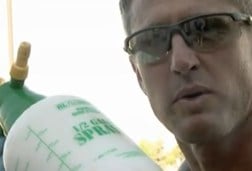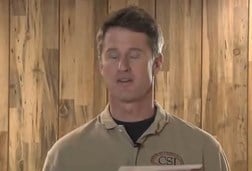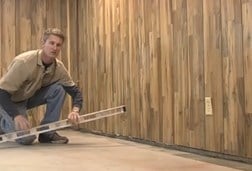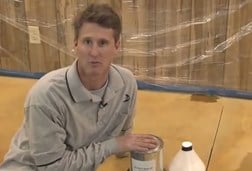- Staining Concrete
- Stamped Concrete
- Concrete Overlays
- Concrete Resurfacing
- Concrete Polishing
- Concrete Dyes
- Colored Concrete
- Indoor Concrete
- Concrete Floors
- Concrete Countertops
- Garage Floor Coatings
- Furniture, Sinks, Fire Bowls
- Basement Floors
- Outdoor Concrete
- Concrete Patios
- Concrete Driveways
- Concrete Pool Decks
- Outdoor Kitchens & Counters
- Outdoor Fireplace
- Concrete Walkways
- Concrete Pavers
- Concrete Walls
- Repair & Maintenance
- Foundation Repair
- Concrete Crack Repair
- Concrete Sealers
- Building with Concrete
- Concrete Homes
- Concrete Basements
- Decorative Concrete
Concrete Repair Video Series
Explanations of common concrete problems and tips for repairWatch a series of easy-to-understand, informative, and entertaining videos from concrete technical expert Chris Sullivan. As the author of a popular online forum, Sullivan explains common problems that arise when installing decorative concrete. He presents quality information in a simple and fun format for understanding why issues arise, and most importantly, ways to prevent and fix problems.
Chris Sullivan is vice president of sales and marketing for ChemSystems Inc. He frequently speaks about troubleshooting decorative concrete at the World of Concrete tradeshow. In his online forum, Sullivan's Corner, he answers technical questions for contractors around the country.
Why Concrete Spalls - Repair Spalled Concrete - Part 1
Time: 05:57
Concrete Network troubleshooting expert Chris Sullivan discusses the main factors contributing to concrete spalling, or scaling, in outdoor concrete slabs. This type of surface failure is more common in colder climates where freeze-thaw cycles cause the water within the capillaries of the concrete to expand, creating pressure that can break away a weak top layer at the concrete surface. Although deicing salts can aggravate the problem, the key culprits are bad mix design and improper finishing practices. Sullivan emphasizes the importance of air entrainment, using the right water-cement ratio, and avoiding overfinishing of the concrete.
Learn more about the benefits of air entrainment in protecting against freeze-thaw expansion.
How to Fix Spalled Concrete - Repair Spalled Concrete - Part 2
Time: 05:17
In Part 2 of his video series on spalled concrete, Sullivan demonstrates how to repair spalling damage using a polymer-modified cementitious overlay, or microtopping. He covers each step in the process, including surface preparation, priming, mixing, and application. He also discusses repair solutions for deep spalling and gives recommendations for sealing the repair.
Learn more about resurfacing concrete with a polymer-modified overlay.
Color Correcting Stamped Concrete
Time: 08:03
Stephanie isn't pleased with the color of her new stamped concrete patio. It was supposed to have beautiful color variations, like natural stone, but instead is monotone and boring. Watch color expert Chris Sullivan totally change the look and add contrast using a topically applied color concentrate. He shows the steps in preparing the surface, how to mix and spray apply the concentrate, and techniques for achieving natural color variations. You'll be amazed by the results. Learn more about how to fix concrete color issues.
Learn more about how to fix concrete color issues.
Surface Preparation - From Carpet to Stained Concrete - Part 1
Time: 06:19
You've finally decided to rip up that ugly, worn carpeting and stain the concrete floor hiding beneath it to create a decorative, low-maintenance surface. But now that the floor is exposed, what's the next step? In this series of videos from Concrete Network expert Chris Sullivan you'll learn all the steps, tools, and techniques needed to properly apply concrete stain and achieve the look you're after. Part 1 deals with surface preparation, including how to assess the condition of the existing concrete, how to test the floor for water absorption and moisture vapor transmission, and how to remove carpet adhesive and other surface contaminants.
For more information, see:
Concrete Crack Repair - From Carpet to Stained Concrete - Part 2
Time: 04:39
One of the most important parts of preparing a concrete floor for a stain or overlay is repairing cracks and divots in the surface. The first step in fixing concrete cracks is chasing the crack with a grinder. This makes the cracks wider in order to allow the repair material to fill the crack. The reason cracks are filled is to avoid shadowing (cracks showing though your topping on the final finished floor). The crack repair material is seeded with sand to help the bonding of the fill material to your final topping. You'll also need to fill divots left by the tack strips your old carpet was attached to. Fill all divots with a cementitious material to get a uniform prepared surface to work with.
Self-Leveling Concrete - From Carpet to Stained Concrete - Part 3
Time: 04:28
When your planning on staining a concrete floor you often need to deal with uneven concrete. Applying a self-leveling concrete overlay or underlayment levels the floor. These products usually require a primer. This product is easy to install. One the self-leveling mix has cured for 10 - 15 minutes you should trowel the edges to a feathered edge so you don't see the edge of the surface on your final colored floor. Uneven concrete occurs when the subsurface (below the concrete) has expansive soils, moisture or high water table, or sub-soil settling. If you still have movement in your slab, then you should order a soils report. Don't spend money on a project that will fail later. To fix this you can use a self-leveling product, raise the entire slab with mud-jacking, or tear out the floor and replace it. Let your self-leveling concrete cure for around 16 hours before applying your microtopping.
Microtopping Installation - From Carpet to Stained Concrete - Part 4
Time: 04:53
One of the most important parts of preparing a concrete floor for a stain or overlay is repairing cracks and divots in the surface. The first step in fixing concrete cracks is chasing the crack with a grinder. This makes the cracks wider in order to allow the repair material to fill the crack. The reason cracks are filled is to avoid shadowing (cracks showing though your topping on the final finished floor). The crack repair material is seeded with sand to help the bonding of the fill material to your final topping. You'll also need to fill divots left by the tack strips your old carpet was attached to. Fill all divots with a cementitious material to get a uniform prepared surface to work with.
Concrete Stain Application - From Carpet to Stained Concrete - Part 5
Time: 04:33
See concrete stain being applied to a concrete microtopping. There are tips on color selection and application of concrete stains and concrete dyes.
Sealing Stained Concrete - From Carpet to Stained Concrete - Part 6
Time: 06:41
Concrete sealer is applied over microtoppings and stained concrete to enhance the color and protect the surface of the concrete from wear and tear. Get tips on sealing concrete from application to adding waxed to protect the sealer.












